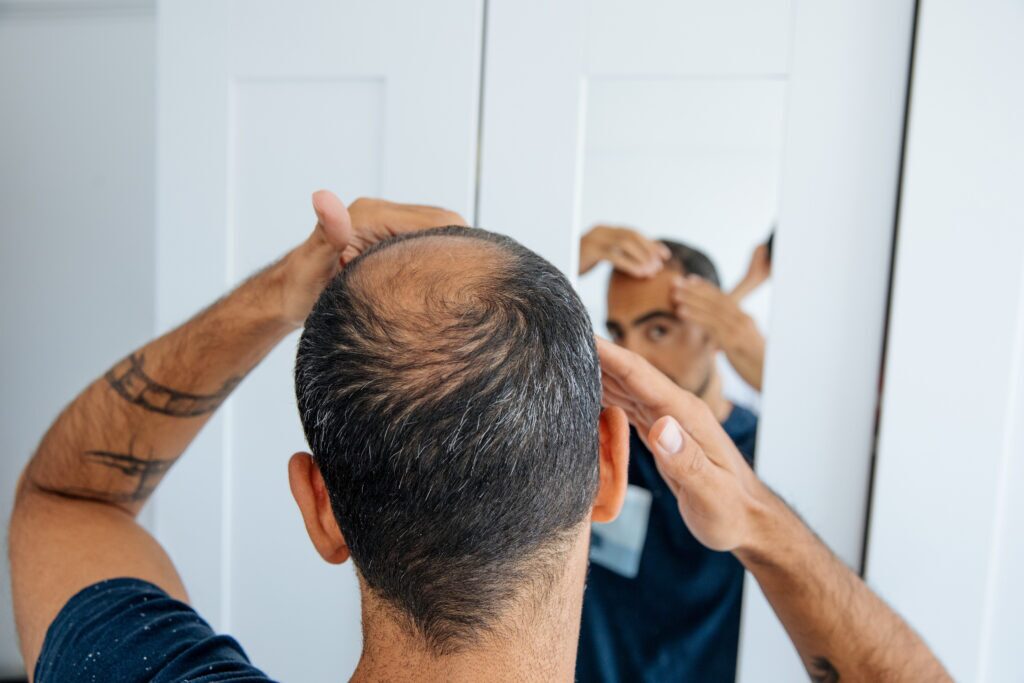Medical Review by Jennie Stanford, MD, FAAFP, DipABOM
Summary:
- Medications like finasteride and minoxidil are proven to combat hair loss, with finasteride reducing DHT levels and minoxidil stimulating hair growth.
- Over-the-counter solutions like minoxidil foam and DHT-blocking shampoos offer another non-invasive approach to managing hair loss.
- Hair transplant surgery is a more permanent solution for severe hair loss, with high satisfaction rates in male patients. Techniques like FUT and FUE show promising results but carry risks like scarring and infection.
- Innovative treatments like stem cell therapies and PRP are showing potential in early studies, although they currently come with high costs and variable outcomes.
A guide to medications, topical therapies, & surgical solutions
Hair loss is a common problem for men, but it’s not inevitable. In fact, there are several different ways in which you can effectively treat hair loss—we’re here to help you understand them so you can choose a solution that’s right for you.
Learn more about online hair loss treatments
There are many different available treatments for hair loss, which can vary in terms of their availability, cost, and effectiveness. Some common types include these:
- Prescription medications: These usually include drugs like finasteride and minoxidil. Finasteride works by reducing the body’s production of dihydrotestosterone (DHT), a hormone that can shrink hair follicles, while minoxidil helps by stimulating hair growth and slowing balding.
Prescription medications can be effective, but they require ongoing use and a doctor’s supervision.
- Topical therapies: These are treatments applied directly to the scalp and can include minoxidil (also available as a topical treatment), as well as other over-the-counter options like shampoos and serums that contain growth stimulants or DHT blockers.
Topical therapies are often chosen by those who prefer a non-invasive approach and are typically used in combination with other treatments.
- Surgical options: A common surgical treatment for hair loss is hair transplantation, where hair follicles from denser areas of the scalp are relocated to balding areas. This option is usually considered by people with significant hair loss who want a permanent solution.
It’s important to note that candidates for hair transplant surgery need to have sufficient donor hair and keep their expectations about the results realistic.
Next, we’ll take a closer look at the science behind each option, as well as the benefits and potential side effects of each approach.
Prescription medications for hair loss
Prescription medications are a common method for treating hair loss. While they aren’t a one-size-fits-all solution, understanding their mechanisms and effects can help you decide if they’re right for you.
Popular Examples
- Finasteride (brand name Propecia®): An oral medication primarily used to treat male pattern baldness.
- Minoxidil (brand names Rogaine®, Regaine®): A topical solution or foam used to stimulate hair growth.
Efficacy
A study published found that finasteride significantly reduced hair loss and increased hair growth in men over a period of two years. Minoxidil has also been found to be effective in promoting hair growth.
Potential side effects
Potential side effects for finasteride include these:
- Sexual dysfunction: A small percentage of men may experience decreased libido, erectile dysfunction, or ejaculation disorders.
- Mood alterations: Rarely, finasteride can lead to mood swings, depression, or anxiety.
- Breast changes: In very few cases, men might notice breast tenderness or enlargement.
Potential side effects for minoxidil include these possibilities:
- Scalp irritation: This can include itching, redness, or dryness at the application site.
- Unwanted hair growth: Occasionally, minoxidil can cause hair growth in areas adjacent to the treatment area, such as the forehead or face.
- Light-headedness: This is rare, occurring in less than 2% of patients.
Topical treatments & shampoos for hair loss
Topical treatments and shampoos are accessible, non-invasive options for managing hair loss, which makes them extremely popular. Their ingredients and effectiveness can vary, but they often represent the most convenient approach to dealing with hair loss.
Types of Topical Solutions
- Over-the-counter minoxidil solutions and foams: Widely used for stimulating hair growth.
- DHT-blocking shampoos: These often contain ingredients like ketoconazole, biotin, or caffeine.
- Hair growth serums and sprays: May include natural ingredients or growth stimulants.
Efficacy
A study in the American Journal of Clinical Dermatology showed that 5% minoxidil foam, when applied once daily, was highly effective for treating male pattern hair loss. A study in the International Journal of Trichology found that certain topical treatments containing natural ingredients like saw palmetto might also promote hair regrowth in some men.
Potential side effects
Topical minoxidil for hair loss has been noted to have several potential side effects:
- Increased hair shedding: Minoxidil can sometimes cause more hair to fall out at first.
- Skin irritation: You might experience redness, discomfort, or a burning feeling on your scalp.
- Scaly scalp: Minoxidil can cause or worsen flakiness or dandruff.
- Itching: Some people feel itchy where they apply minoxidil.
- Allergic reactions: Redness, rash, and itching can happen if you’re allergic to minoxidil or the ingredients in it. If this happens, a foam version without certain ingredients might help.
- Unwanted hair growth: Minoxidil can cause extra hair to grow in other areas, especially with higher concentrations or if taken orally.
Hair transplant surgery for hair loss
Hair transplant surgery is a significant and long-term solution for men who are experiencing considerable hair loss. It’s invasive compared to other treatments but offers lasting results.
Surgical Options
- Follicular unit transplantation (FUT): Involves removing a strip of scalp with hair and transplanting it.
- Follicular unit extraction (FUE): Individual hair follicles are extracted and transplanted.
Efficacy
The Journal of Cutaneous and Aesthetic Surgery observed that the majority of male patients experienced satisfactory results. The study evaluated outcomes of FUE in men with male pattern baldness and found that around 98% of the participants reported satisfaction with the density and appearance of hair growth after the procedure.
Potential Side Effects
- Scarring: Especially in FUT, where a strip of scalp is removed.
- Infection: As with any surgery, there’s a risk of infection at the incision sites.
- Unnatural-looking results: If not done properly, transplants can look artificial.
Emerging technologies & therapies for hair loss
There are also several relatively new technologies being pursued as potential treatments for hair loss—however, many of these lack either sufficient testing or peer-reviewed research for most healthcare providers to recommend their use.
Experimental treatment options
- Stem cell therapies aimed at regenerating hair follicles.
- Platelet-rich plasma (PRP) treatments that involve injecting a concentration of a patient’s own platelets into the area affected by hair loss.
- Laser therapy and low-level light therapy devices designed for home use.
Current research
Preliminary studies show advancement in stem cell therapy and PRP treatments—indicating that these may be more widely available in the near future.
Potential risks
- Discomfort or pain: Especially in treatments like PRP injections.
- Inconsistent results: Emerging technologies may offer variable outcomes.
- High cost: Newer therapies can be expensive and are often not covered by insurance.
Finding the right choice for you with Lemonaid Health
Choosing the right path for treating hair loss depends on your individual health history and the risks you are willing to take. It’s also important to note that many factors contribute to hair health—including stress, diet, and more.
Working with a healthcare professional can help you take a holistic approach for revitalizing your hair. Lemonaid Health can help by providing online consultations for hair loss with medical experts based in the United States.
Propecia® is a registered trademark of Johnson & Johnson. Rogaine® is a registered trademark of Johnson & Johnson. Regaine® is a registered trademark of Johnson & Johnson.












